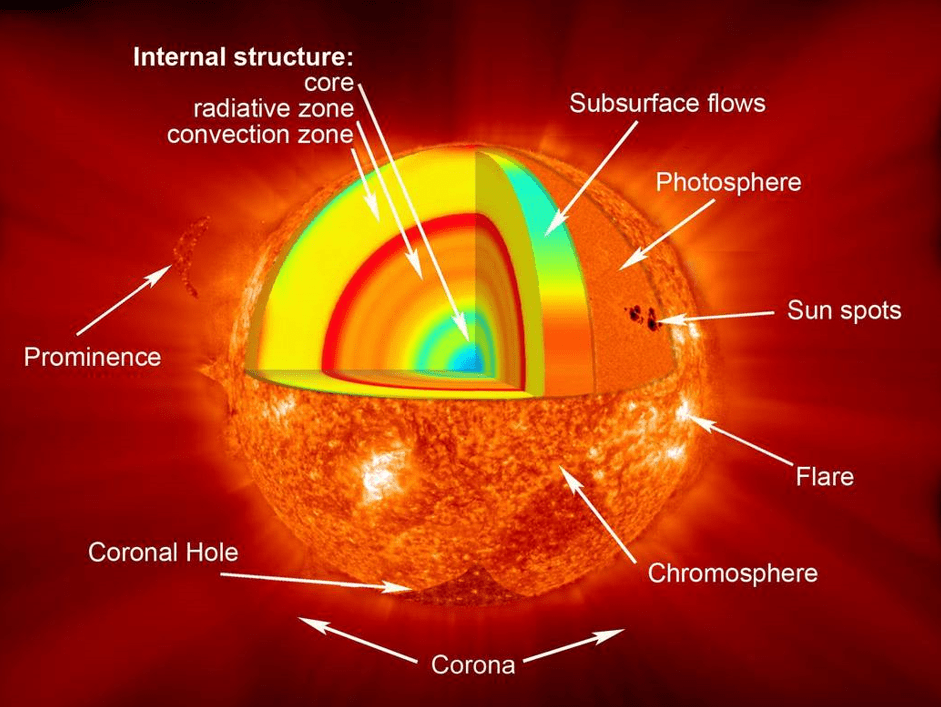3 Min Read How Does the Sun Behave? (Grades K-4) This article is for students grades K-4. The Sun is a star. It is the biggest object in our solar system. The Sun is about 93 million miles away from Earth and about 4.5 billion years old. The Sun affects Earth’s weather, seasons, climate, and more. Let’s learn about how the Sun behaves. Why is the Sun warm and bright? The Sun is a giant ball made of hydrogen and helium gases. Deep in the center of the Sun, hydrogen…
Read MoreTag: For Kids and Students
NASA Knows: How Does the Sun Behave? (Grades 5-8)
This article is for students grades 5-8. The Sun is the star of our solar system. Its gravity holds Earth and our planetary neighbors in its orbit. At 865,000 miles (1.4 million km) in diameter, it’s the largest object in our solar system. On Earth, its influence is felt in our weather, seasons, climate, and more. Let’s learn about our dynamic star and its connections to life on Earth. What is the Sun, and what is it made of? The Sun is a yellow dwarf star. It is approximately 4.5…
Read MoreNASA Knows – How Can I Get Involved With NASA Research?
5 min read Preparations for Next Moonwalk Simulations Underway (and Underwater) NASA provides a variety of pathways for those outside the agency to contribute to authentic and meaningful research. Whether you’re a student pursuing a degree in STEM (science, technology, engineering, or mathematics), an educator looking for new ways to engage your classroom, or a citizen scientist enthusiastic about sharing your observations, there’s a wide array of opportunities to get involved in NASA research. Citizen scientists around the world participate in environmental observation and measurement efforts through GLOBE. NASA Everybody…
Read MoreBundling the Best of Heliophysics Education: DigiKits for Physics and Astronomy Teachers
Learn Home Bundling the Best of… For Educators Overview Learning Resources Science Activation Teams SME Map Opportunities More Science Activation Stories Citizen Science 3 min read Bundling the Best of Heliophysics Education: DigiKits for Physics and Astronomy Teachers For nearly a decade, the American Association of Physics Teachers (AAPT) has been working to bring together resources through its DigiKits–multimedia collections of vetted high-quality resources for teachers and their students. These resources are toolkits, allowing teachers to pick and choose interesting content to support their instruction. As a partner with…
Read MoreHello Earth? Space Calling
NASA astronaut Nick Hague with the International Space Station’s amateur or ham radio equipment during his current mission (right) and a previous flight five years ago (left) NASA How it started versus how it’s going for astronaut Nick Hague with ISS Ham Radio on the space station. Since November 2000, crew members like Hague have used ham radio to communicate with people on Earth through this educational program, also known as Amateur Radio on the International Space Station or ARISS. So far, there have been more than 1,700 events, directly…
Read MoreRead With NASA: Books, More to Inspire Young Explorers
Flight Engineer Joe Acaba holds a children’s book that he is reading from as part of the Story Time From Space program. Astronauts read aloud from a STEM-related children’s book while being videotaped and demonstrate simple science concepts and experiments aboard the International Space Station. Stories open up new worlds and spark curiosity in readers of all ages – and NASA is using the power of storytelling to encourage the Artemis Generation to explore STEM (science, technology, engineering, and mathematics). Through the below list of reading resources – books, comics,…
Read MoreLaunch Your Creativity with These Space Crafts!
9 min read Launch Your Creativity with These Space Crafts! In honor of the completion of our Nancy Grace Roman Space Telescope’s spacecraft — the vehicle that will maneuver the observatory to its place in space and enable it to function once there — we’re bringing you some space crafts you can complete at home! Join us for a journey across the cosmos, starting right in your own pantry. Stardust Slime Did you know that most of your household ingredients are made of stardust? And so are you! Nearly every…
Read MoreGoing Back-to-School with NASA Data
4 min read Preparations for Next Moonwalk Simulations Underway (and Underwater) As students head back to school, teachers have a new tool that brings NASA satellite data down to their earthly classrooms. The My NASA Data homepage categorizes content by areas of study called spheres and also Earth as a system. NASA/mynasadata.larc.nasa.gov For over 50 years of observing Earth, NASA’s satellites have collected petabytes of global science data (that’s millions and millions of gigabytes) – with terabytes more coming in by the day. Since 2004, the My NASA Data website has…
Read MoreNASA@ My Library and Partners Engage Millions in Eclipse Training and Preparation
2 min read NASA@ My Library and Partners Engage Millions in Eclipse Training and Preparation The Space Science Institute, with funding from the NASA Science Mission Directorate and Gordon and Betty Moore Foundation, provided unprecedented training, support, and supplies to 15,000 libraries in the U.S. and territories in support of public engagement during the 2023 and 2024 eclipses. From September 2022 to September 2024, these efforts included: Co-development efforts with 3 NASA@ My Library Partner Libraries in the “Square of Awesome” (where both the total and annular eclipse crossed) led…
Read MoreSlow Your Student’s ‘Summer Slide’ and Beat Boredom With NASA STEM
4 Min Read Slow Your Student’s ‘Summer Slide’ and Beat Boredom With NASA STEM Creating and testing soda-straw rockets is a fun way for younger students to avoid the “summer slide” and stay engaged in STEM during summer vacation. Credits: NASA The school year has come to an end, and those long summer days are stretching ahead like an open runway. Parents and educators often worry about the “summer slide,” the concept that students may lose academic ground while out of school. But summer doesn’t mean students’ imaginations have to…
Read More








